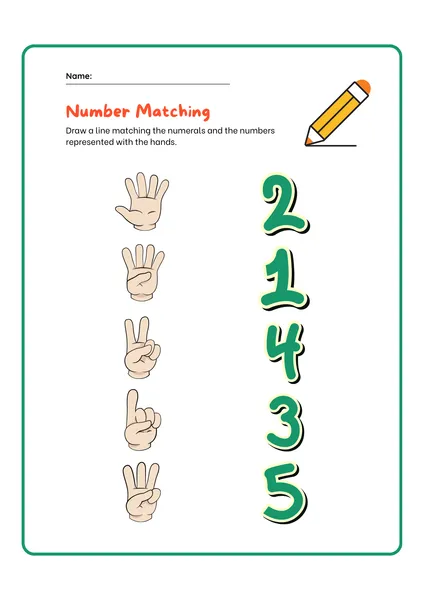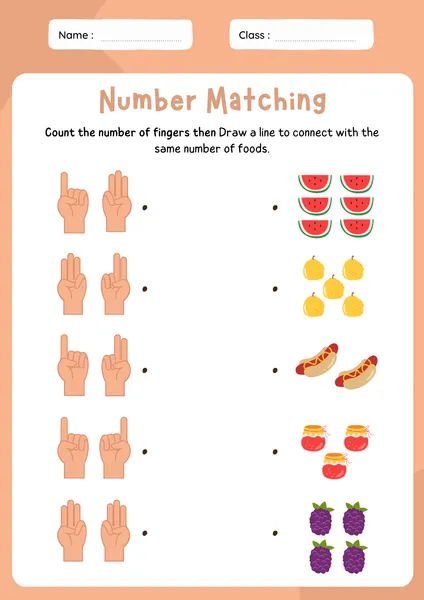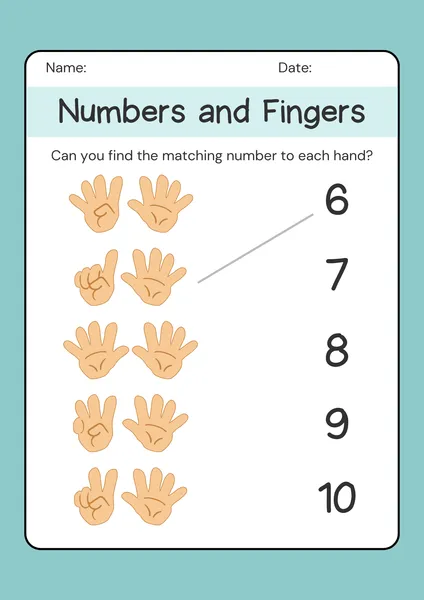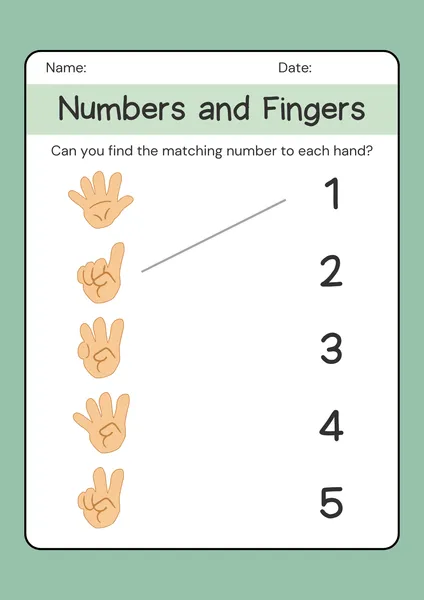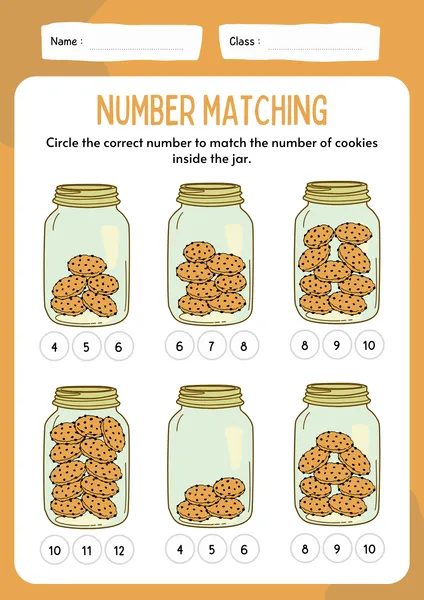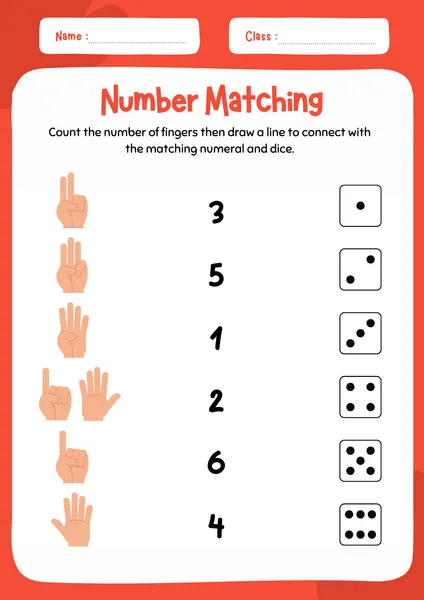Matching worksheets for kindergarten: Students should develop an early liking for mathematics since it will remain among the most important in their academic careers. But it is not easy to teach numbers to young children. That is why we extend much effort into ensuring that the tasks of recognising these numbers are performed in various activities and games. So here are some of my favourite techniques for teaching number recognition. We will use easy number-matching worksheets for kindergarten and numbers represented by different elements, such as dots, objects, and tally marks.
Why is Number Recognition Important?
Here’s how number recognition helps:
Foundation for Mathematical Understanding
Digits are the bare roots of mathematics. Just identifying them will help you know their importance and how they are related to one another. This understanding paves the way for more complex mathematical concepts like:
- Counting: Recall that children who learn ‘3,’ as a numeral, can point to 3 objects correctly.
- Addition and Subtraction: Recognising numbers lets a child know that when two groups are combined, or one group is taken from another, the quantity of each is changed.
- Place Value: This is a key idea that takes good number recognition as its foundation—where the position of a digit in a number is equated to the value of that digit, as in 123.
- Fractions: First, let us consider simple recognition of the numbers belonging to a given concept; even the idea of the fraction is built on this notion.
Cognitive Development
Learning to recognise numbers isn’t just about math; it boosts a child’s overall cognitive skills:
- Pattern Recognition: People use numbers in many ways, and some are combined (such as on dice or dominoes). Advertisement of these patterns enhances the capabilities of a child in another area since patterns are needed in, for example, reading, problem-solving and logical abilities.
- Sequencing: Digit comes in a specific sequence. Learning this order enables children to remember sequences and avoid difficulties arranging information.
- Memory: Your memory strengthens when you recall what each written number looks like and correctly identify the associated value.
- Problem-Solving: Number recognition is usually used in early number problems to enable a child to reason and find a solution to the problem independently.
Real-World Applications:
Therefore, number recognition is not solely confined to the classroom. Children use it in their everyday lives:
- Understanding Quantity: Thus, knowing what “2” is enables them to make sense that they have two cookies, two toys and so on.
- Telling Time: Telling time involves recognising numbers on a clock, hence the importance of helping a child learn to identify these numbers.
- Following Instructions: Many games and activities entail counting, and when a child must follow suit, he must first identify the numbers involved.
- Everyday Tasks: Starting from identifying house number plates to even reading prices on commodities & services, using number recognition never stops in the real world.
- Boosts Confidence: Generally, learning numbers make children more confident, particularly when identifying the numbers they have learned. It also creates the conditions for the subject, mateof matics, to become a lifelong lover.
Making Number Recognition Fun
Children below the mandatory school-going age understand things better through play. Here are some fun and engaging activities that can help kindergarteners learn number recognition:
Number Matching Games:
Numbers can otherwise be taught through matching games, which is effective for children to master numbers. The cards should be placed in pairs of two, and you can use bought matching games or make them using index cards.
You can write numbers only on one set of cards and make corresponding dots, objects, or tally marks on the other. Children can then take turns placing the cards in the correct order for a matching game.
Counting Songs and Rhymes:
Songs and rhymes are a good way to help children learn the numbers they need to count and also can help to influence their sequences.
In general, there are many counting songs and counting rhymes that children enjoy singing along to
Hands-on Activities:
Practical actions help teachers make numeracy meaningful and more relatable to young children. One can use a particular stock of such means as blocks, counters, and toys at early childhood learners’ disposal to teach numbers.
For example, you can request children to count as many blocks as specific or to arrange counters of different colours in a particular way.
Interactive Worksheets:
Hence, worksheets help practise number recognition. However, the preparation that warrants worksheets must be as engaging to young kids as possible. You can have colourful worksheets with different themes or add flash items like stickers or cutouts.
Easy Number Matching Worksheets for Kindergarten
Here are some examples of easy number-matching worksheets that you can use with your kindergarten students:
Worksheet 1: This worksheet is titled Dots Matching
This worksheet involves the identification of numerals to the dots.
Materials:
- Worksheet with numerals 1-10
- They also need a pen; if it is not a marker to draw dots, then dot stickers.
Instructions:
- Give each learner a piece of paper that is blank apart from the following instructions in capital letters at the top of the page:
- Students do the worksheets by placing the dot stickers on the numeral of their choice with the number of dots for the numeral and, where necessary, drawing the dots.
Worksheet 2: Objects Matching
This worksheet is used to initiate the children to relate numerals with objects in the real world.
Materials:
- Worksheet with numerals 1-10
- Visual graphics of the objects of 1 apple, 2 banana, 3 car.
- Glue or tape
Instructions:
- Hand out each student a worksheet and a set of pictures.
- Bring students to match the pictures in the worksheet to the correct numerals using glue or scotch to stick them properly.
Worksheet 3: Tally Marks Matching
This worksheet helps the learner understand that tally marks can also be used to represent numbers.
Materials:
- Number writing activity involving numbers one to ten, and the tally marks the corresponding numbers.
- Crayons or markers
Instructions:
- Hand over the worksheet to each of the students.
- Ask students to link every numeral with its tally marks by drawing a line over them.
Worksheet 4: Mixed Representations Matching
This worksheet involves mixing different number representations to form a challenge for the students.
Materials:
- Kindergarten teachers can use this worksheet containing numbers, dots, objects, and tally marks.
- Pencil or pen
Instructions:
Give a worksheet to each of the students.
Teach students to connect the dots with a line with the counterparts if they see numerals and the object pictures side by side with tally marks.
Strategies on How to Apply the Number Matching Worksheets
Start with Simple Worksheets
The first arithmetic worksheets should contain numbers up to five; as kids advance, the numbers increase.
Make it Hands-on
Secondary to this, teachers should urge children to use manipulatives or draw a representation of the papers.
Provide Positive Reinforcement
Encourage children and emphasise their efforts even though they may be messy in their work.
Keep it Fun
The use of fun themes and exciting colours in the form of worksheets and other interactive items helps keep children interested.
Differentiate Instruction
Therefore, it is helpful to offer different difficulty levels to be more appropriate for individual needs.
Beyond Worksheets: Below are more Number Recognition activities:
- Number Scavenger Hunt: Take small number cards, scatter them around the classroom, and let the children look for them.
- Number Puzzles: Make number puzzles on a single handwritten on index cards or cardboard.
- Number Bingo: Instead of letters, use number cards and play bingo.
- Number Hopscotch: Make a board with numbers and have the children hop to the number you tell them.
- Number Beanbag Toss: On the buckets or containers, write the numbers, blow a whistle, and have the children throw bean bags in the particular container with the number you said.
- Cooking Activities: Use measuring cups and spoons to teach basic numbers when baking or cooking.
- Story Time: Use books that teach children counting and number recognition skills.
Conclusion
It can be very satisfying to teach number recognition to kindergarteners one-on-one or in groups. To teach young children mathematics successfully, using games such as number matching games, counting along with tracing and counting, and interactive number worksheets is helpful. Stay playful, encourage learners and adapt instructional methods based on the needs of a learner. By taking your time and using some flair, a child can be taught to embrace learning from an early age.
